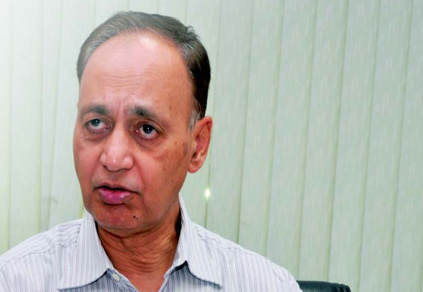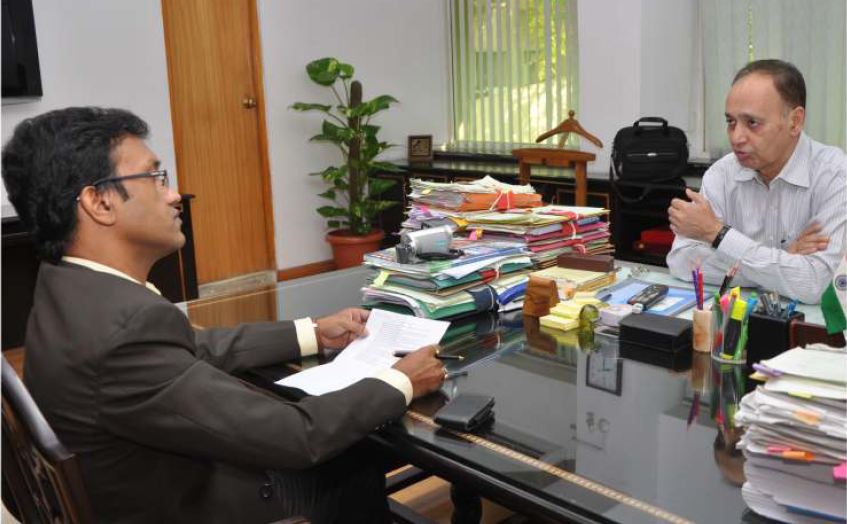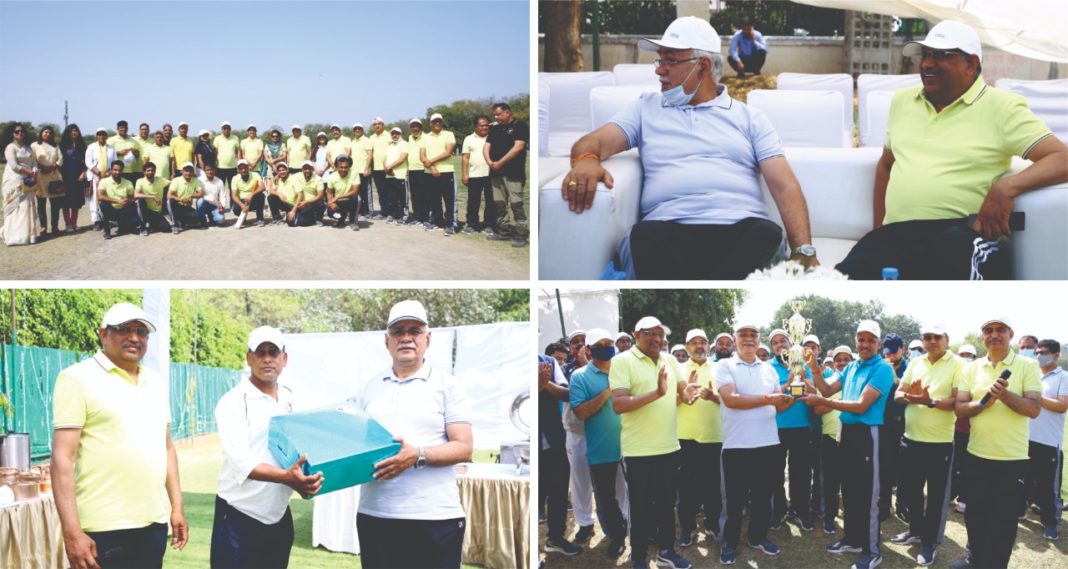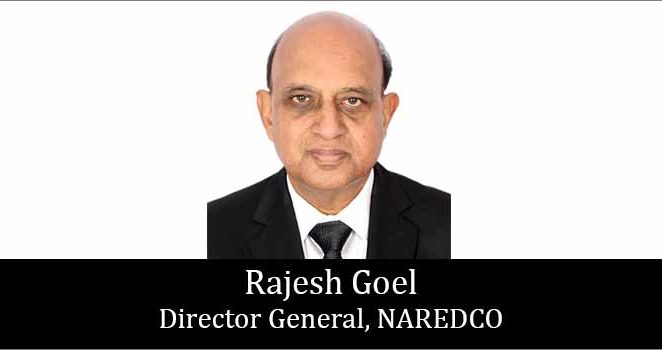Interviews
REALTY GAME CHANGER


Exuding confidence in the real estate regulatory bill, Arun Misra, Union Secretary, Ministry of Housing and Urban Poverty Alleviation, told Editor Palash Roy in an exclusive interview that it is the first step towards bringing in transparency, ethics, fair play into the realty sector and will mark the beginning of reform in a sector which has acquired a bad name.
PR: Why is the real estate regulatory bill taking so long?
AM: I don’t think it is taking long. The Bill was actually circulated in 2011. In July 2011, we got the clearance that we can actually legislate the real sector. Within one and half years we have been able to get the Bill drafted, and we have now been able to introduce it in Parliament. Also what I gather is that there is universal appreciation from all quarters of consumers and other people from across the country.
PR: You think once it is enacted it will change the whole scenario in the realty sector?
AM: That’s the whole point. Basically this will be the first step towards bringing in transparency, ethics, fair play into the sector. So this will be the beginning of reform in the sector. As such this sector has acquired kind of a bad reputation, which may or may not be true, but it is there. By this Bill, the transactions will be clean. So I am quite hopeful hat all the political parties will support it. Because the newspaper reports that I have seen, the commentaries that I have heard, they have all been very appreciative. In fact we had our very first presentation before the parliamentary committee last week. This is just the beginning.
PR: But there were expectations that the Bill will be taken up in the Monsoon session of Parliament?
AM: We introduced it only in this session. The standard practice is that whenever it is introduced in a particular session, it goes to the standing committee. So it was not meant to be taken up. It was only meant to be introduced and referred to the standing committee, which was done.
PR: You expect it to be taken up in the Winter session?
AM: I can’t say. For anything, the standing committee requires at least two to three months. Winter session is sometime in December. Let’s see. You were talking about the Land Acquisition Bill, for which the standing committee took more than a year.
PR: There is an estimated shortage of about 19 million urban housing units which is increasing by about 2 million every year. However the most crucial issue is the availability of land. What steps are you taking to create a land bank?
AM: Out of the 18.8 million housing units shortage, almost 15 million units is because of the congestion factor, congestion in the sense that the individuals already have a house which may be small but just an upgrade is enough. In effect, only about 3 million odd housing units have to be completely constructed anew. Secondly, we have witnessed a very heartening feature—in the last one decade the rate of addition in the housing stock has been higher than the rate of population growth. So honestly we do not expect the shortage to increase in the next ten years. In fact, the shortage is definitely likely to come down in the next ten years.
PR: Please can you explain that a little more?
AM: We had about 52 million houses in 2001 which has grown to 78 million houses. So we added about 50 percent to the total housing stock in the last one decade. So in the next one decade, if we maintain the same pace of growth which we are sure we will, the shortage will not be that high.
PR: Land prices are expected to go up post the land acquisition bill which is likely to be enacted soon. Don’t you think this will be a major roadblock in the way of affordable or low-cost housing?


The second issue is regarding the land acquisition bill. I know a lot of people say that acquisition of land will become difficult and land is going to become more expensive. But my personal experience shows that in the last ten to fifteen years land prices have really gone up. So I really am one of those individuals who feel that land acquisition bill is not going to enhance land prices to a substantial extent.
If you were able to acquire an acre of land for say `3-4 lakh earlier, that same very plot is now bought for `50 lakh, `75 lakh or even a crore. It is not that land prices have not gone up.
PR: Why do you think so?
AM: Land prices have anyway gone up substantially in the last one decade and farmers have become very alert. I can talk about my personal experience—ten years ago we were able to acquire land in the NCR region for about seven to eight lakh rupees per acre. But last year I don’t think there has been any place in the NCR region where you can buy land for less `75 lakh rupees to one crore rupees an acre. So the price rise has been substantial. So I don’t anticipate this will go any further.
If it goes up any further then everything becomes non-viable, and I am also sure that farmers do not expect too much of a rise. All that they have been wanting and what we have denied them so far was a proper market price. The land acquisition bill gives them a proper market price. Today the acquisition cost is anyway not very different or very far away from the actual market price. So I don’t think that is going to be major issue.


AM: Our first focus area is there will be some government programmes and there shall be some policies which will induce the private
sector and the state governments to come up with such programmes. The government programmes where we do public funding are
the Jawarharlal Nehru Urban Renewal Mission (JNURM) and the Rajiv Awas Yojna (RAY). These programmes give capital subsidy—substantial capital subsidy for improvement of the slums and for improvement of housing in the slum areas—that forms one part.
The second part is what we call Rajiv Rinn Yojna (RRY) wherein we try to give loans andmoney at a subsidised interest so that people can take loans to construct their own houses.The third part is to induce the private sector to come up and construct houses. Our role is to provide some amount of subsidy to those
people to construct houses so that the houses are made available to the poorer sections at a cheaper price. So these are the three major thrust in the first roadmap.
The core of the second roadmap is the National Urban Livelihood Mission, in which we provide skill training to the urban poor and also money at subsidised interest rates to set up entrepreneurship programmes and start individual enterprises.
PR: What steps have you have taken till date to address the housing need for the urban poor? What results have these steps yielded till date?
AM: Under JNURM, we had targeted to set up a million houses for the urban poor of which about 700,000 houses have either been completed or are under various stages of completion, and I feel about 300,000 to 400,000 will come up by the end of next year.
Under RAY, we have again sanctioned a fairly large amount of funds which can support the construction of about a million more houses for the urban poor. Under RRY too, we want to fund construction of another one more million houses for the urban poor.
Under RAY, we have already sanctioned projects worth about `2500 crore, and in the next four years we plan to sanction projects of about `25,000 to `30,000 crore. Under RRN, we have kept aside about `4000 crore which can be used as interest subsidy to meet housing needs of the poor.
PR: You were talking about the Rajiv Rinn Yojna (RRY) under which loan of upto `5 lakh is given under a subsidised interest rate regime. The scheme has recently been launched. Is the scheme taken off well?


PR: Are you doing anything specific to create awareness about RRY?
AM: Yes. Like I said we already have had discussions with the state governments and bankers. Now our officers will go down to various parts of the country and discuss the scheme with state governments and also may be put it up before the states’ lead bankers’ committee. We are also writing to the finance ministry and the Reserve Bank of India to issue guidelines on this. The idea, among other things, is also to create awareness.
PR: Is the government taking steps towards technology upgrade which will reduce housing construction time, thereby reducing the costs?
AM: The Building Materials & Technology Promotion Council (BMTPC) has already identified seven to eight global processes and technologies. They have already gone through a global tendering process. Out of the seven processes, two have already been tested, and two have already found wide acceptance in the private sector. What we have started doing is to try and involve the government sector in this technology. How do we do it?
One major way of doing it is to change the schedule of rates which is mandated by the CPWD or the state PWD departments and officers
will have to follow that. Unless you make amendments there, for a field officer it is very difficult to bring in the technology.
So we have taken up with CPWD that these new technologies should be approved for government constructions also. The private sector has already started doing it. So out of eight, two have already been introduced, and I am very sure that over a period of time the rest five to six processes and technologies will also be taken in.
PR: Which are the states that are very aggressive in the creation of low cost housing?
AM: There are two ways of looking at it. One way is by looking at states that have been able to utilise the money that has been given to them. Certain states have done very well. States like Gujarat and Madhya Pradesh have done well. But there are some states where there have been problems. For bringing in new policies, Rajasthan has taken lead, and some states that encourage low cost housing include Rajasthan, Odisha, and Karnataka. All these states are coming up with very pro-affordable housing policies.
PR: And the states which are not doing well in terms of affordable housing?
AM: There have been problems with Delhi, but they have picked up. There is a very large amount of unspent money in Maharashtra and a solution is being sought. Uttar Pradesh also has a very large balance. Some states like Punjab have not been very active in JNURM. Now that we have given one year extra to all the states, I am sure most of them will be able to make up.
PR: Since long the industry is demanding infrastructure status. What is the status on that?
AM: We have been taking this up with the ministry of finance and DIPP, they still have to take a call on this. You know when you talk about infrastructure, basically, the understanding is a project which caters to public good— a road, a dam, a power plant or a port—all these cater to public good. When you talk of housing, it doesn’t conform to the public good. It’s a private good. What we are trying to say is don’t treat individual houses as public good, but if you take affordable housing project as such, may be, this can be considered as infrastructure, but the discussions are on.
PR: Getting an infrastructure status will help the industry in getting cheap funds?
AM: There are other ways of getting cheap funds also, in the sense we have allowed external commercial borrowing to the extent of one billion dollar per year, so that gives you cheap funds. FDI is already allowed, and we are going to further liberalise FDI in housing, affordable housing. The finance ministry has already allowed five percent interest subsidy. Then the one percent interest subvention was also allowed. Then SEBI has also taking steps towards Real Estate Investment Trusts. So there are other ways also to get cheap money.
PR: Absence of a single window clearance is resulting in delays of projects and escalation of costs. Why is it not happening?
AM: That’s true. Getting clearances is always very time-taking and at times expensive proposition which adds to the cost of housing. We are sensitising state governments about it, and we are guiding them on how to reduce the time taken for approvals. The issues are with the state governments but by and large they are being sensitised. We have to take it up with the ministry of forest and environment. That’s the other major ministry we have to deal with. We will try to standardise as much as possible.
PR: Now that you have touched upon the issue, environmental clearances have become one of the major bottlenecks which is causing delay in projects. Are you doing anything to address this?
AM: See, it is not only us, if you see, the coal ministry has problems, the power ministry has problems, so the forest & environment clearance problem is not only with the housing sector. That is something that we must understand. They have certain rules, certain regulations, and they uniformly apply to all the sectors, be it is mines, be it steel, be it power, be it is coal, housing, irrigation, whatever. So the idea is to try and find out some way in which these processes can be simplified.
PR: How has Hudco’s performance been like?
AM: Hudco has done very well. In the last two years, they have been able to get an excellent category rating. We still want to do more in the field of urban housing, and the balance between infrastructure development and housing will have to be maintained. But Hudco by and large have been doing fairly well.
-



 News3 weeks ago
News3 weeks agoKW Delhi 6 Mall Onboards New Brands
-



 News3 weeks ago
News3 weeks agoManasum Senior Living Launches IKIGAI GOA, A Senior Living Community in North Goa, in collaboration with Prescon Homes
-



 News2 weeks ago
News2 weeks agoGodrej Properties Sells Rs 3k cr+ Homes of Godrej Zenith, Gurugram, within 3 days
-



 News3 weeks ago
News3 weeks agoBridging India Divide: Top 5 Tier- 2 Cities to Focus On
-



 News3 weeks ago
News3 weeks agoCommercial Realty Gets Tech Savvy: Fast Construction, Enhanced Convenience
-



 News3 weeks ago
News3 weeks agoMultipoint Connection – A Definite Boon
-



 News2 weeks ago
News2 weeks agoRBI’s Status Quo on Key Policy Rates to Help Maintain the Real Estate Growth Momentum, Say Industry Stalwarts
-



 News3 weeks ago
News3 weeks agoSacred Cities See a Retail Boom as Spiritual Tourism Surge: CBRE Report



























